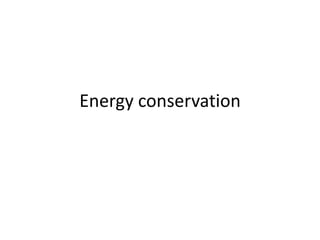Recommended
More Related Content
What's hot
What's hot (18)
Role of biomass in the mitigation of energy crises in pakistan

Role of biomass in the mitigation of energy crises in pakistan
Geo-Thermal Heat Pump – Application Aspects in India

Geo-Thermal Heat Pump – Application Aspects in India
Bioenergy - a clean renewable energy source to combat climate change

Bioenergy - a clean renewable energy source to combat climate change
Similar to Energy conservation 1
Similar to Energy conservation 1 (20)
Renewable Energy's Impact Upon Hydrocarbon Dominance

Renewable Energy's Impact Upon Hydrocarbon Dominance
Renewable and Non renewable resources by Komal Bhardwaj

Renewable and Non renewable resources by Komal Bhardwaj
Climate change and mitigation measures for sustainability.

Climate change and mitigation measures for sustainability.
Conventional energy and non conventional sources of energy in india

Conventional energy and non conventional sources of energy in india
More from bgriesmer
More from bgriesmer (20)
Energy conservation 1
- 2. Energy conservation Facts • Energy conservation- reducing energy use. • Over 70% of electricity in the U.S. is generated from non-renewable sources. • If the energy efficiency of commercial and industrial buildings improved by 10%, it would equal a reduction in greenhouse gas emissions equal to taking 30 million cars off the road.
- 3. Energy conservation Facts • Energy can be conserved by using renewable resources. • There are 5 types of renewable resources. • Solar, Hydroelectric, Biomass fuels, Geothermal, and Wind. • The EIA estimates that about 19% of world electricity generation is from renewable energy.
- 4. Solar energy • Solar energy is energy from the sun. • Solar energy is captured by solar panels. • About 0.22% of US energy comes from solar energy.
- 5. Solar Energy
- 6. Hydroelectric Energy • Hydroelectric energy is energy from moving water. • The water moves and turns a turbine that generates electricity. • 6% of US energy comes from Hydroelectric energy.
- 8. Biomass Fuels • Biomass fuels are made from living things. • Biomass fuels are burned to get energy. • 4.6% of US energy comes from biomass fuels.
- 10. Geothermal Energy • Geothermal energy is energy from Earth’s heat. • Geothermal pumps are used to tap into this resource. • .4% of US energy comes from geothermal energy.
- 12. Wind Energy • Wind energy is energy produced by wind. • Wind spins a wind turbine which generates electricity. • 1.4% of US energy comes from wind energy.
- 13. Wind Energy
- 14. The End
